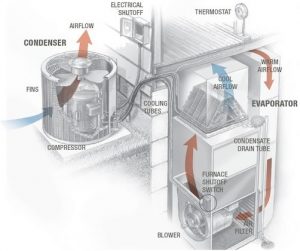No one relies on their air conditioning like South Floridians. But how much do you know about how your air conditioning system works? As it happens, the process is simple: refrigerant cools the air in your home, releases the heat it gathers, and returns to do more cooling. The feats of engineering necessary to get there, though, are intricate.
The more you know about your AC system, the better you’ll be able to keep it in good working order. This guide takes you step-by-step through the cooling process and the equipment that does the job.
All air conditioners operate by removing heat from the home and transferring it outside. Knowing a bit about how this happens is the key to staying on top of your system’s performance.
Air conditioners have three main components: the evaporator, the condenser, and the compressor. The evaporator typically sits inside the home. The condenser and compressor are typically outdoors, for reasons we’ll get to in just a moment. Here’s how these components, and the coolant that runs through them, work together in a typical central cooling system.
Intake
Using the same ductwork as the heating system, a blower fan draws warm air through return registers located around the home. These are often found near the ceiling, since warm air rises.
Cooling
Warm air passes through the evaporator, a system of copper or aluminum coils through which refrigerant, or coolant, flows. The refrigerant draws heat from the air, cooling it down. In the process, the air releases some of its water content, the same way that warm air can produce rain when it encounters a cold front. A drain line collects this condensation and diverts it back outdoors.
The blower fan continues to push the now-cooled air back throughout the house. But what about the coolant?
Hot Refrigerant?
By the time the evaporator has chilled the air, the refrigerant flowing through its pipes has absorbed a tremendous amount of heat, enough to turn it from a liquid into a gas. That’s where the condenser and compressor—the outdoor components of a typical central air system—come into play. Their job is to return the refrigerant to a liquid state and to help it shed the heat it absorbed from the warm air entering the evaporator.

Compression
Before the refrigerant can return to duty in the evaporator, two things need to happen. It must change from a gaseous to a liquid state, and it must shed an awful lot of heat. This must happen somewhat quickly, to keep enough refrigerant flowing to the evaporator. The most efficient way to achieve all this is to treat the superheated refrigerant in two steps, one handled by the compressor, the other by the condenser.
The compressor is the heart of any AC system. It is responsible for circulating refrigerant and for preparing it for rapid cooling in the condenser. It does so by increasing the refrigerant’s pressure, making it easier to quickly radiate enough heat before it returns to the evaporator. This comes with a tradeoff: increasing the pressure of a gas also increases its temperature. The condenser’s discharge line is the hottest single part of your entire AC system.
The sheer power needed to achieve this change, the intense conditions involved, and the precision with which the refrigerant must be treated make the compressor the most complex and expensive part of an AC system.
By now, the refrigerant is even hotter than before—up to 275 degrees Fahrenheit—but at least it’s close to returning to a liquid state. The condenser takes things from there.
Condensing
The condenser takes all the heat that’s been pulled from your home and created by the compressor and releases it into the outdoor air. It does this by operating a bit like the evaporator coil in reverse. Superheated refrigerant enters the condenser nearly ready to change into a liquid, and passes through coils fitted with heat-conducting fins. A fan blows air over this coil, and heat flows from the refrigerant into the coil and through the fins.
Other Components
Each of the main parts of your AC system relies on smaller components to run efficiently. Filters in the compressor and air vents, for instance, keep particles out of the system and should be cleaned or replaced regularly. The drain pipe should also be inspected for stoppages and cleaned every so often.
Putting it All Together
Basic knowledge of your AC system’s components and their functions can go a long way toward keeping your house cool and your maintenance costs down. For example, freezing condensation on an evaporator coil might keep the system from functioning properly, but it’s probably not the end of the world. In this case, the evaporator is telling you that for some reason, the coolant isn’t drawing enough heat from the air passing over it. Most of the time, this simply means that a return register is obstructed and not allowing enough warm air to pass over the evaporator, or that you need to add some coolant since not enough is present to complete the liquid-gas-liquid cycle that your system depends on.
Whether your air conditioning system needs a simple tuneup a serious overhaul or a complete replacement, we can help. In the meantime, we hope that this little guide has helped you better understand how your system works and what you can do to keep it in top condition.








